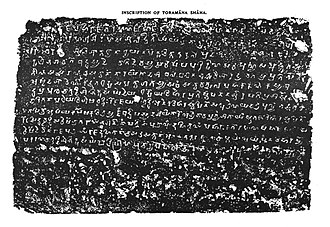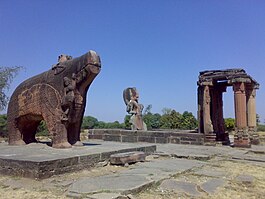Toramana
| Toramana | |
|---|---|
| Ruler of theAlchon Huns | |
 | |
| Reign | 493-515 |
| Predecessor | Mehama |
| Successor | Mihirakula |
| Religion | Shaivism |
Toramanaalso called Toramana Shahi Jauvla[3](Gupta script:![]()
![]()
![]()
![]() Toramāṇa,[4]ruled circa 493-515 CE) was a king of theAlchon Hunswho ruled in northern India in the late 5th and the early 6th century CE.[5]Toramana consolidated the Alchon power inPunjab(present-dayPakistanand northwesternIndia), and conquered northern and central India includingEraninMadhya Pradesh.Toramana used the title "Great King of Kings" (Mahārājadhirāja
Toramāṇa,[4]ruled circa 493-515 CE) was a king of theAlchon Hunswho ruled in northern India in the late 5th and the early 6th century CE.[5]Toramana consolidated the Alchon power inPunjab(present-dayPakistanand northwesternIndia), and conquered northern and central India includingEraninMadhya Pradesh.Toramana used the title "Great King of Kings" (Mahārājadhirāja![]()
![]()
![]()
![]()
![]()
![]()
![]() ), equivalent to "Emperor",[6]in his inscriptions, such as theEran boar inscription.[7]
), equivalent to "Emperor",[6]in his inscriptions, such as theEran boar inscription.[7]
TheSanjeliinscription of Toramana speaks of his conquest and control over Malwa and Gujarat. His territory also includedUttar Pradesh,RajasthanandKashmir.[8]He probably went as far asKausambi,where one of his seals was discovered.
According to theRīsthal inscription,discovered in 1983, theAulikaraking Prakashadharma ofMalwadefeated him.[9][10]
Overview[edit]
Toramana is known fromRajatarangini,through coins and inscriptions.
Punjab inscription[edit]
An inscription found at Kura in theSalt Rangerecords the building of a Buddhist monastery by a person named Rotta Siddhavriddhi during the reign of theHunaruler Toramana. The donor expresses the wish that the religious merit gained by his gift be shared by him with the king and his family members.[11]In theKhurā inscription(495-500, from theSalt RangeinPunjaband now in Lahore), Toramana assumes the Indian regnal titles in addition to central Asian ones:Rājādhirāja Mahārāja Toramāṇa ShahiJauvla.[3][12][13]Among which Shahi is considered to be his Title and Jauvla being an epithet or Biruda. This is a Buddhist record in hybrid Sanskrit, recording the gift of a monastery (vihāra) to members of theMahīśāsakaschool.[14][15]

 Gupta script:
Gupta script:


 Toramāṇa,appears in the 1st line of the inscription
Toramāṇa,appears in the 1st line of the inscriptionGwalior inscription of Mihirakula[edit]

In theGwalior inscription of Mihirakula,fromGwaliorin northernMadhya Pradesh,India, and written inSanskrit,Toramana is described as:
"A ruler of [the earth], of great merit, who was renowned by the name of the glorious Tôramâna; by whom, through (his) heroism that was specially characterized by truthfulness, the earth was governed with justice."
Eran Boar inscription[edit]


TheEranBoar inscription (inEran,Malwa, 540 km south ofNew Delhi,state ofMadhya Pradesh) of his first regnal year indicates that easternMalwawas included in his dominion. The Eran Boar inscription was erected in honor of the deityVishnuas his avatar,Varaha.
Om!Victorious is the god (Vishnu), who has the form of aBoar;who, in the act of lifting up the earth {out of the waters}, caused the mountains to tremble with the blows of {his} hard snout; {and) who is the pillar {for the support) of the great house which is the three worlds!
— Eran Boar Inscription
The statue is of the deity in form of a boar, with engravings display it protectingrishisand upholdingDharma.Additionally, the statue containsSanskritinscriptions inscribed on the neck of the boar, in 8 lines of inBrahmi script. It also records the building of the temple in which the currentVarahaimage stands, by Dhanyavishnu, the younger brother of the deceased Maharaja Matrivishnu.[18]The first line of the inscription, made after 484/85 CE mentions the "Maharajadhiraja Toramana"(" The great king of king Toramana ")[2]and reads:
"In year one of the reign of the King of Kings Sri-Toramana, who rules the world with splendor and radiance...."
Sack of Kausambi[edit]
The presence of seals in the name of "Toramana" and "Hunaraja" inKausambi,suggests that the city was probably sacked by the Alkhons under Toramana in 497–500.[2][20][21][22]
Defeats[edit]


 "Tora"inBrahmi scriptappear in large letters on the reverse, under the solar wheel design.[23][24]
"Tora"inBrahmi scriptappear in large letters on the reverse, under the solar wheel design.[23][24]












 Mahārājadhirāja Shrī Toramāṇa( "Great King of Kings, Lord Toramana" ), in theGupta script,in theEran boar inscription.[7]
Mahārājadhirāja Shrī Toramāṇa( "Great King of Kings, Lord Toramana" ), in theGupta script,in theEran boar inscription.[7]
| Alchon Huns (400–670 CE) | ||||||||||||||||||||||||||||||||||||||||||
|---|---|---|---|---|---|---|---|---|---|---|---|---|---|---|---|---|---|---|---|---|---|---|---|---|---|---|---|---|---|---|---|---|---|---|---|---|---|---|---|---|---|---|
|
||||||||||||||||||||||||||||||||||||||||||
According to theRishtal stone-slab inscription,discovered in 1983, theAulikaraking Prakashadharma ofMalwadefeated him in 515 CE.[9][2]
Toramana may also have been defeated by the Indian EmperorBhanuguptaof theGupta Empirein 510 A.D. according to theEraninscription, although the "great battle" to which Bhanagupta participated is not explicited.[29][30][31]
A few silver coins of Toramana closely followed the Gupta silver coins. The only difference in the obverse is that the king's head is turned to the left. The reverse retains the fantailed peacock and the legend is almost similar, except the change of name to Toramana Deva.[32][33]
A Jaina work of the 8th century, theKuvalayamalastates that he lived in Pavvaiya on the bank of theChandrabhagaand enjoyed the sovereignty of the world.[34]
Successor[edit]
Toramana was succeeded by his sonMihirakula.[35]
See also[edit]
Notes[edit]
- ^ALRAM, MICHAEL (2003)."Three Hunnic Bullae from Northwest India"(PDF).Bulletin of the Asia Institute.17:180, Figure 11.ISSN0890-4464.JSTOR24049314.
- ^abcdHans Bakker24th Gonda lecture
- ^abAgrawal, Ashvini (1989).Rise and Fall of the Imperial Guptas.Motilal Banarsidass Publ.ISBN978-81-208-0592-7.
- ^Fleet, John Faithfull (1960).Inscriptions Of The Early Gupta Kings And Their Successors.p.162.
- ^Grousset, Rene (1970).The Empire of the Steppes.Rutgers University Press. pp.70-71.ISBN0-8135-1304-9.
- ^"the Huna emperor Toramana" inAgrawal, Ashvini (1989).Rise and Fall of the Imperial Guptas.Motilal Banarsidass Publ. p. 251.ISBN9788120805927.
- ^abFleet, John Faithfull (1960).Inscriptions Of The Early Gupta Kings And Their Successors.pp.158–161.
- ^Dani, Ahmad Hasan(1999).History of Civilizations of Central Asia: The crossroads of civilizations, A.D. 250 to 750.Motilal Banarsidass Publ. p. 142.ISBN8120815408.Retrieved5 November2012.
- ^abOjha, N.K. (2001).The Aulikaras of Central India: History and Inscriptions,Chandigarh: Arun Publishing House,ISBN81-85212-78-3,pp.48-50
- ^Salomon, Richard (1989). "New Inscriptional Evidence For The History Of The Aulikaras of Mandasor".Indo-Iranian Journal.32(1): 27.doi:10.1163/000000089790082971.ISSN0019-7246.JSTOR24654606.
- ^Upinder Singh (2017).Political Violence in Ancient India.Harvard University Press. p. 240.ISBN9780674981287.
- ^Katariya, Adesh (25 November 2007).Ancient History of Central Asia: Yuezhi origin Royal Peoples: Kushana, Huna, Gurjar and Khazar Kingdoms.Adesh Katariya.
- ^Gupta, Parmanand (1977).Geographical Names in Ancient Indian Inscriptions.Concept Publishing Company.
- ^"Siddham. The Asian Inscription Database | IN00101 Khura Inscription of Toramana".Retrieved19 November2019.
- ^Burgess (1892).Epigraphia Indica Vol 1.Archaeological Society of India. pp.238–245.
- ^Balogh, Dániel (12 March 2020).Hunnic Peoples in Central and South Asia: Sources for their Origin and History.Barkhuis. pp. 326–327.ISBN978-94-93194-01-4.
- ^Burgess, James (1898).Epigraphia Indica Vol.1.pp. 238–241.
- ^Fleet, J.F.(1888).Corpus Inscriptionum Indicarum.Vol. 3. Calcutta: Government of India, Central Publications Branch.
- ^Coin Cabinet of the Kunsthistorisches Museum Vienna
- ^Indian History, Allied Publishersp.81
- ^Dynastic History of Magadha, Cir. 450-1200 A.D., by Bindeshwari Prasad Sinhap.70
- ^Geography from Ancient Indian Coins & Seals, by Parmanand Guptap.175
- ^ALRAM, MICHAEL (2003)."Three Hunnic Bullae from Northwest India"(PDF).Bulletin of the Asia Institute.17:180, Figure 11.ISSN0890-4464.JSTOR24049314.
- ^Dani, Ahmad Hasan; Litvinsky, B. A. (1996).History of Civilizations of Central Asia: The crossroads of civilizations, A.D. 250 to 750.UNESCO. p. 175.ISBN9789231032110.
- ^CNG Coins
- ^The Identity of Prakasaditya by Pankaj Tandon,Journal of the Royal Asiatic Society,October 2015.
- ^Tripathi, Rama S. (1989).History of Kanauj: To the Moslem Conquest.Motilal Banarsidass Publ. p. 45 Note 1.ISBN9788120804043.
- ^Smith, Vincent Arthur; Edwardes, S. M. (Stephen Meredyth) (1924).The early history of India: from 600 B.C. to the Muhammadan conquest, including the invasion of Alexander the Great.Oxford: Clarendon Press. p. Plate 2.
- ^Archaeological Excavations in Central India: Madhya Pradesh and Chhattisgarh, by Om Prakash Misrap.7
- ^Encyclopaedia of Indian Events & Dates by S. B. Bhattacherje A15
- ^The Classical Age by R.K. Pruthi p.262
- ^Gupta, P.L. (2000).Coins,New Delhi: National Book Trust,ISBN81-237-1887-X,p.78
- ^The Identity of Prakasaditya by Pankaj Tandonp.661,with photograph
- ^Mahajan V.D. (1960, reprint 2007).Ancient India,S.Chand & Company, New Delhi,ISBN81-219-0887-6,p.519
- ^"Gwalior Stone Inscription of Mihirakula"(PDF).Project South Asia. Archived fromthe original(PDF)on 12 August 2011.Retrieved5 April2009.

